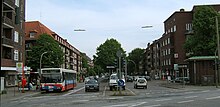| Hamm | |
|---|---|
| Quarter of Hamburg | |
 Störtebeker-Haus Störtebeker-Haus | |
Location of Hamm in Hamburg
 | |
  | |
| Coordinates: 53°33′18″N 10°03′27″E / 53.55487°N 10.05742°E / 53.55487; 10.05742 | |
| Country | Germany |
| State | Hamburg |
| City | Hamburg |
| Borough | Hamburg-Mite |
| Area | |
| • Total | 3.8 km (1.5 sq mi) |
| Population | |
| • Total | 38,868 |
| • Density | 10,000/km (26,000/sq mi) |
| Time zone | UTC+01:00 (CET) |
| • Summer (DST) | UTC+02:00 (CEST) |
| Dialling codes | 040 |
| Vehicle registration | HH |


Hamm is a quarter in the borough of Hamburg-Mitte, in the eastern part of Hamburg, Germany. Once a popular garden suburb of rich traders and merchants, in the first half of the 20th century it grew to become one of the most populated quarters of Hamburg. In the Second World War, however, the area was mostly flattened. As of 2020 the population was 37,989.
Between 1951 and 2010 Hamm was subdivided into three neighborhoods: Hamm-Nord, -Mitte und -Süd (Hamm-North, -Middle, and South). On 1 January 2011, this subdivision was repealed and the three were again combined.
Demographics
As of 2013 Hamm had 26,122 households. The majority of inhabitants, 73.9%, were between 18 and 65. The proportion of immigrants was 32.9%, significantly lower than in Hamburg-Mitte as a whole (45.3%).
Politics
These are the results of Hamm in the Hamburg state election:
| Election | SPD | Greens | Left | CDU | AfD | FDP | Others |
|---|---|---|---|---|---|---|---|
| 2020 | 35,6 % | 27,6 % | 12,6 % | 06,1 % | 06,0 % | 03,0 % | 09,1 % |
| 2015 | 47,5 % | 12,7 % | 11,3 % | 10,3 % | 06,7 % | 04,7 % | 06,8 % |
| 2011 | 50,3 % | 12,2 % | 08,5 % | 16,6 % | – | 04,3 % | 08,1 % |
| 2008 | 38,3 % | 09,2 % | 07,8 % | 37,1 % | – | 04,1 % | 03,5 % |
| 2004 | 34,6 % | 10,9 % | – | 42,0 % | – | 02,7 % | 09,8 % |
| 2001 | 41,5 % | 07,6 % | 00,5 % | 22,9 % | – | 03,5 % | 24,0 % |
| 1997 | 40,1 % | 12,5 % | 00,6 % | 27,2 % | – | 02,3 % | 17,3 % |
| 1993 | 44,7 % | 12,1 % | – | 21,8 % | – | 02,8 % | 18,6 % |
Religion
Like most of the Hamburg area, after the Reformation Hamm was mostly Lutheran. After the Church of the Trinity was built in 1693 Hamm was its own parish, which initially also comprised Horn and part of Eilbek. In the 19th and 20th centuries an increase in population led to the foundation of multiple daughter-parishes (Dankeskirche 1895, Wichernkirche 1934, Pauluskirche 1955, Simeonkirche 1965/66), some of which reunited into a larger parish (with 7400 parishioners) because of lowered membership.
Since the 1950s there have been a Catholic community (Herz Jesu Hamm) and a number of free churches (a Methodist church, a Baptist church, and an independent Evangelical-Lutheran church) in Hamm. In recent times a Greek Orthodox church and a mosque have been added.
References
- "Bevölkerung in Hamburg am 31.12.2023 nach Stadtteilen". Statistisches Amt für Hamburg und Schleswig-Holstein. May 2024.
- "Bevölkerung in Hamburg am 31.12.2020" (PDF). Statistisches Amt für Hamburg und Schleswig-Holstein. 23 April 2021.
- Friederike Ulrich, "Hamm: Ballettschule, Fabrik der Künste, Bunkermuseum: Das Viertel bietet überraschend viel", Die Stadtteilserie, Hamburger Abendblatt, May 26, 2012 (in German)
- Hamburger Stadtteil-Profile 2013 Archived 2013-02-28 at the Wayback Machine, ISSN 1863-9518, Statistisches Amt für Hamburg und Schleswig-Holstein, 2014 (in German)
- Ev.-Luth. Kirchengemeinde zu Hamburg-Hamm Archived 2012-02-16 at the Wayback Machine (in German)
| Freie und Hansestadt Hamburg | |
| Government and symbols | |
| History and culture | |
| Economy and transport | |